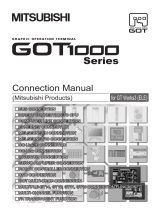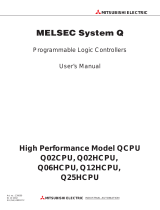
15
TERMS
Unless otherwise specified, this manual uses the following generic terms and abbreviations.
* indicates a part of the model or version.
Q33B, Q35B, Q38B, Q312BQ3B
Term Description
Series
Q series The abbreviation for Mitsubishi MELSEC-Q series programmable controller
AnS series
The abbreviation for compact types of Mitsubishi MELSEC-A series programmable
controller
A series The abbreviation for large types of Mitsubishi MELSEC-A series programmable controller
CPU module type
CPU module
A generic term for the Basic model QCPU, High Performance model QCPU, Process
CPU, Universal model QCPU, Motion CPU, C Controller module, and PC CPU module.
The term in this manual does not include the Redundant CPU because it cannot be used
in a multiple CPU system.
QCPU
A generic term for the Basic model QCPU, High Performance model QCPU, Process
CPU, and Universal model QCPU.
The term in this manual does not include the Redundant CPU because it cannot be used
in a multiple CPU system.
Basic model QCPU
A generic term for the Q00CPU and Q01CPU.
The term in this manual does not include the Q00JCPU because it cannot be used in a
multiple CPU system.
High Performance model QCPU A generic term for the Q02CPU, Q02HCPU, Q06HCPU, Q12HCPU, and Q25HCPU
Process CPU A generic term for the Q02PHCPU, Q06PHCPU, Q12PHCPU, and Q25PHCPU
Universal model QCPU
A generic term for the Q00UCPU, Q01UCPU, Q02UCPU, Q03UDCPU, Q03UDVCPU,
Q03UDECPU, Q04UDHCPU, Q04UDVCPU, Q04UDEHCPU, Q06UDHCPU,
Q06UDVCPU, Q06UDEHCPU, Q10UDHCPU, Q10UDEHCPU, Q13UDHCPU,
Q13UDVCPU, Q13UDEHCPU, Q20UDHCPU, Q20UDEHCPU, Q26UDHCPU,
Q26UDVCPU, Q26UDEHCPU, Q50UDEHCPU, and Q100UDEHCPU.
The term in this manual does not include the Q00UJCPU because it cannot be used in a
multiple CPU system.
Built-in Ethernet port QCPU
A generic term for the Q03UDVCPU, Q03UDECPU, Q04UDVCPU, Q04UDEHCPU,
Q06UDVCPU, Q06UDEHCPU, Q10UDEHCPU, Q13UDVCPU, Q13UDEHCPU,
Q20UDEHCPU, Q26UDVCPU, Q26UDEHCPU, Q50UDEHCPU, and Q100UDEHCPU
High-speed Universal model QCPU
A generic term for the Q03UDVCPU, Q04UDVCPU, Q06UDVCPU, Q13UDVCPU, and
Q26UDVCPU
Motion CPU
A generic term for the Mitsubishi motion controllers: Q172CPUN, Q173CPUN,
Q172HCPU, Q173HCPU, Q172CPUN-T, Q173CPUN-T, Q172HCPU-T, Q173HCPU-T,
Q172DCPU, Q173DCPU, Q172DCPU-S1, Q173DCPU-S1, Q172DSCPU, and
Q173DSCPU
PC CPU module
A generic term for the MELSEC-Q series-compatible PC CPU modules manufactured by
CONTEC Co., Ltd: PPC-CPU686(MS)-64, PPC-CPU686(MS)-128, and PPC-
CPU852(MS)-512
C Controller module
A generic term for the C Controller modules: Q06CCPU-V, Q06CCPU-V-B, Q12DCCPU-
V, Q24DHCCPU-V, and Q24DHCCPU-LS
CPU module model
QnU(D)(H)CPU
A generic term for the Q00UCPU, Q01UCPU, Q02UCPU, Q03UDCPU, Q04UDHCPU,
Q06UDHCPU, Q10UDHCPU, Q13UDHCPU, Q20UDHCPU, and Q26UDHCPU.
The term in this manual does not include the Q00UJCPU because it cannot be used in a
multiple CPU system.


























